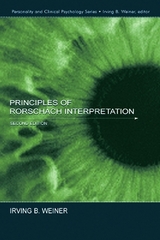
Principles of Rorschach Interpretation
Seiten
1998
Lawrence Erlbaum Associates Inc (Verlag)
978-0-8058-3108-5 (ISBN)
Lawrence Erlbaum Associates Inc (Verlag)
978-0-8058-3108-5 (ISBN)
- Titel erscheint in neuer Auflage
- Artikel merken
Zu diesem Artikel existiert eine Nachauflage
This textbook of Rorschach interpretation integrates the basic ingredients of structural, thematic, behavioural and sequence analysis into systematic guidelines for describing personality functioning.
A clinician-friendly, comprehensive guide to utilizing the Rorschach has long been awaited. Principles of Rorschach Interpretation is a textbook of Rorschach interpretation that integrates the basic ingredients of structural, thematic, behavioral, and sequence analysis into systematic guidelines for describing personality functioning. The book is divided into three parts.
Part I addresses basic considerations in Rorschach testing and consists of chapters dealing with conceptual and empirical foundations of the inkblot method and with critical issues in formulating and justifying Rorschach inferences.
Part II comprises six chapters concerned with elements of interpretation contributing to thorough utilization of the data in a Rorschach protocol: The Comprehensive System search strategy, the complementary roles of projection and card pull in determining response characteristics, and the interpretive significance of structural variables, content themes, test behaviors, and the sequence in which various response characteristics occur. Each chapter presents and illustrates detailed guidelines for translating Rorschach findings into descriptions of structural and dynamic aspects of personality functioning. Throughout, emphasis is on the implications of Rorschach data for personality assets and liabilities, with specific respect to adaptive and maladaptive features of the manner in which people attend to their experience, use ideation, modulate affect, manage stress, view themselves, and relate to others.
Part III presents 10 case illustrations of how the interpretive principles delineated in Part II can be used to identify assets and liabilities in personality functioning and applied in clinical practice. These 10 cases represent persons from diverse demographic backgrounds and demonstrate a broad range of personality styles and clinical issues. The case discussions touch on numerous critical concerns in arriving at differential diagnoses, formulating treatment plans, and elucidating structural and dynamic determinants of behavior.
A clinician-friendly, comprehensive guide to utilizing the Rorschach has long been awaited. Principles of Rorschach Interpretation is a textbook of Rorschach interpretation that integrates the basic ingredients of structural, thematic, behavioral, and sequence analysis into systematic guidelines for describing personality functioning. The book is divided into three parts.
Part I addresses basic considerations in Rorschach testing and consists of chapters dealing with conceptual and empirical foundations of the inkblot method and with critical issues in formulating and justifying Rorschach inferences.
Part II comprises six chapters concerned with elements of interpretation contributing to thorough utilization of the data in a Rorschach protocol: The Comprehensive System search strategy, the complementary roles of projection and card pull in determining response characteristics, and the interpretive significance of structural variables, content themes, test behaviors, and the sequence in which various response characteristics occur. Each chapter presents and illustrates detailed guidelines for translating Rorschach findings into descriptions of structural and dynamic aspects of personality functioning. Throughout, emphasis is on the implications of Rorschach data for personality assets and liabilities, with specific respect to adaptive and maladaptive features of the manner in which people attend to their experience, use ideation, modulate affect, manage stress, view themselves, and relate to others.
Part III presents 10 case illustrations of how the interpretive principles delineated in Part II can be used to identify assets and liabilities in personality functioning and applied in clinical practice. These 10 cases represent persons from diverse demographic backgrounds and demonstrate a broad range of personality styles and clinical issues. The case discussions touch on numerous critical concerns in arriving at differential diagnoses, formulating treatment plans, and elucidating structural and dynamic determinants of behavior.
Contents: Preface. Part I: Basic Considerations in Rorschach Testing. The Nature of Rorschach. Approaches to Rorschach Interpretation. Part II: Elements of Interpretation. The Comprehensive System Search Strategy. Projection and Card Pull in Rorschach Responses. Interpreting Structural Variables. Interpreting Content Themes. Interpreting Test Behaviors. Conducting a Sequence Analysis. Part III: Identifying Adaptive Strengths and Weaknesses: Case Illustrations. Introduction to Case Illustrations. Attending to Experience. Using Ideation. Modulating Affect. Managing Stress. Viewing Oneself and Relating to Others.
| Erscheint lt. Verlag | 15.5.2007 |
|---|---|
| Verlagsort | Mahwah |
| Sprache | englisch |
| Maße | 152 x 229 mm |
| Themenwelt | Geisteswissenschaften ► Psychologie ► Psychoanalyse / Tiefenpsychologie |
| Geisteswissenschaften ► Psychologie ► Test in der Psychologie | |
| ISBN-10 | 0-8058-3108-8 / 0805831088 |
| ISBN-13 | 978-0-8058-3108-5 / 9780805831085 |
| Zustand | Neuware |
| Haben Sie eine Frage zum Produkt? |
Mehr entdecken
aus dem Bereich
aus dem Bereich
vom Mythos zur Psychoanalyse des Selbst
Buch | Softcover (2023)
Kohlhammer (Verlag)
28,00 €
Grundlagen, Behandlungstechnik und Anwendung
Buch | Softcover (2022)
Kohlhammer (Verlag)
35,00 €



